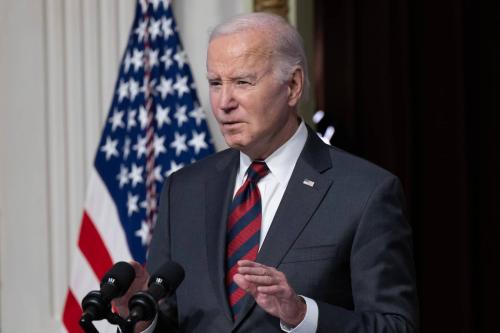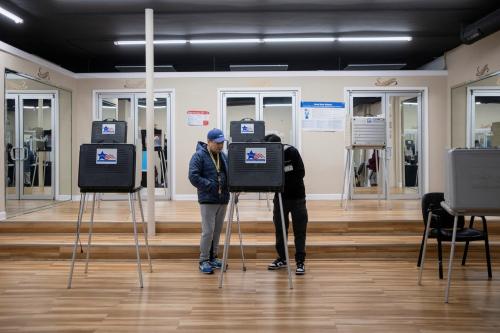Former President Donald J. Trump is now the GOP’s presumptive presidential nominee. Looking ahead to Trump’s rematch with President Joe Biden in November, some analysts believe that Trump’s electoral base is expanding to include more Black, Hispanic, and Asian voters.
Undoubtedly so. But the evidence that Democrats are “hemorrhaging” minority support and are on the losing side of an impending “racial realignment” is less clear than Trump supporters hope and than Biden supporters fear. Likewise, seven months out from Election Day, Biden’s post-State of the Union surge in the polls is neither important nor insignificant.
Nobody, however, can doubt that white working-class voters, defined simply as white voters without a college degree, are a key to Trump’s past, present, and pending electoral fortunes. I certainly don’t, for reasons both analytical (parsing relevant polling and election data) and anecdotal (knowing white working-class relatives and friends who used to be “Reagan Democrats,” became ex-urban Republicans, and are now “MAGA Republicans”).
But three facts about Trump’s support among white working-class voters are not generally recognized or understood.
First, several other Republican presidential standard-bearers, as well as many GOP candidates for Congress, won about the same share or an even greater share of white working-class votes than Trump did in 2016 and 2020. And, in 2022, Make-America-Great-Again (MAGA)-identified Republicans in many states did less well than Republicans who distanced themselves from Trump.
Second, Will Marble, a brilliant Penn data scientist, has documented that since 2000, “educational polarization” between whites with a college degree and whites without one has widened on both economic and cultural issues and pushed ever more “non-college” whites “toward the Republican Party.”
But might that polarization be more pronounced for working-class white evangelicals than it is for other whites without a college degree? That is what seems to be suggested by exit polls showing that in both 2016 and 2020, Trump won white working-class evangelicals but lost other white working-class voters.
Third, white evangelical working-class voters and other white working-class voters differ with respect to their positions on many policy issues and might also differ in relation to the types of campaign-messaging that do the most to mobilize and motivate them to vote for or against a given candidate or party.
Trump v. Romney
In the March 2021 edition of Perspectives on Politics, political scientists Nicholas Carnes and Noam Lupu painstakingly analyzed survey and voting data on how the white working-class voted in 2016. They found no evidence that “Trump himself uniquely mobilized the white working class.”
As I explained in American Purpose,1 in 2016 and again in 2020, Trump’s support among white working-class voters was not unprecedented. Take a look at Figure 1 below. It is adapted from Carnes and Lupu’s summary of their study for The Washington Post.
The narrative that fits these numbers is that after winning a white working-class majority with Ronald Reagan, the GOP lost it in the 1990s but got it back to about even in the 2000s. Then, first with Mitt Romney and then with Trump, it won over 55%, a share not seen since Ronald Reagan’s reelection; and, in 2020, Biden knocked three points off Trump’s 2016 take.
In 2022, Trump-touted, MAGA-messaged GOP candidates, like Ohio’s J.D. Vance and Georgia’s Herschel Walker, fared less well with working-class white voters than Republican candidates in their respective states who distanced themselves from Trump, like Ohio’s Mike DeWine and Georgia’s Brian Kemp.
In the 2022 midterms, working-class whites broke 66% for Republicans versus 32% for Democrats—66% besting the highest share of that vote received by Trump (62% in 2016); and Florida Governor Ron DeSantis was reelected with 70% of the state’s white working-class vote.
Which white working class?
When it comes to presidential primaries and general elections, it is useful to understand the “white vote” as comprised of at least four sub-electorates: white evangelicals with college degrees; white evangelicals without college degrees; white Catholics and other non-evangelical whites with college degrees; and white Catholics and other non-evangelical whites without college degrees.
According to New York Times election polls, in 2020, 67% of those who cast a ballot for president were white, and about 28% of those who cast a ballot for president in 2020 were white evangelical Christians. So, about 42% of the total white vote-casting electorate in 2020 consisted of white evangelicals.
White voters without a college degree were about 35% of all 2020 voters, and about 52% of all white voters. Judging by American National Election Studies data and Public Religion Research Institute data, about 45% of white 2020 voters without a college degree were white evangelicals while about 55% were non-evangelical whites.
So, we can estimate that about 16% of the total vote-casting 2020 electorate (45% of 35%) consisted of white evangelicals with no college degree, while about 19% (55% of 35%) of it was comprised of non-evangelical working-class whites.
In 2020, based on NBC News polls,2 84% of working-class white evangelicals who voted cast a ballot for Trump. That was four points better than the 80% majority among working-class white evangelical voters that Trump received in 2016.
But what about the non-evangelical white working-class? What about the predominantly urban and suburban blue-collar white Catholics and non-evangelical Protestant whites without college degrees who most people still call to mind when they hear “white working class”?
Take a look at Table 1 and Table 2. In 2016, non-evangelical white working-class voters supported Hillary Rodham Clinton over Trump by 22 points (58% to 36%). In 2020, they voted for Biden over Trump by 15 points (56% to 41%). The gap between the two white working-class votes for Trump was 44 points in 2016 (80% versus 36%) and 43 points in 2020 (84% to 41%).
Glance back at Figure 1. It shows that Trump’s 2020 share of the white working-class vote was 59%. Now look again at Table 2. It would appear that Trump got to that solid 2020 white working-class majority by winning 84% of the white evangelical working-class voters who were 45% of the total white 2020 vote-casting electorate and 16% of the total 2020 vote-casting electorate, plus 41% of the non-evangelical white working-class voters who were 55% of the total white non-college 2020 vote-casting electorate and 19% of the total 2020 vote-casting electorate.
White evangelicals are a larger share of Republican primary voters than they are of general election voters. For example, in this year’s GOP South Carolina presidential primary, white evangelicals were 61% of the state’s vote-casting electorate. Trump won big in South Carolina by beating the state’s ex-Governor Nikki Haley 71% to 29% among white evangelicals. But among all other South Carolina GOP primary voters, Haley beat Trump 55% to 44%.
Still, even in evangelical-dominated GOP primaries, the voting gap between the two white working classes remains in double digits. Take a look at Table 3. It aggregates data across South Carolina and five other states in which NBC News conducted both exit and entrance polls through mid-March 2024: California, Iowa, New Hampshire, Ohio, and Virginia.
In these states, Trump received 89% of the votes cast by white evangelicals without college degrees, versus 76% of the votes cast by all other white working-class voters—a 13-point gap.
Of Catholic plumbers and born-again professors
In July 2016, New York’s Democratic Senator Chuck Schumer made this prediction: “For every blue-collar Democrat we lose in western Pennsylvania, we will pick up two moderate Republicans in the suburbs of Philadelphia, and you can repeat that in Ohio and Illinois and Wisconsin.”
As it turned out, Clinton didn’t win that many more moderate Republican votes, but she also did not lose the blue-collar non-evangelical white working-class vote, and neither did Biden in 2020.
I am not at all sure what explains why non-evangelical working-class whites did not give Trump a majority of their votes in 2020. Nor do I know why Trump’s share of the votes cast by college-educated white evangelicals fell from 81% in 2016 to 63% in 2020, or why he got “only” 71% of their vote in this year’s early GOP primaries. And I have no real handle on what, if anything, either group’s voting in 2016 and 2020 portends for this year’s election.
But permit me to offer a conjecture or two, prefaced by a conceptual riff that only an old political science professor could love. Some three decades ago, in the opening chapter of a Congressional Quarterly volume parsing the 1992 elections, Donald E. Stokes, a founding father of American national election studies, and I explained that there are two kinds of issues that matter in presidential elections: position issues and valence issues.
A position issue is one on which the rival parties or candidates reach out for the support of the electorate by taking different positions on a policy question that divides the electorate, like tariffs, high or low (or no); or abortion, pro-life or pro-choice; or fracking, yay or nay.
But there are also issues on which voters distinguish parties and candidates, not by their real or perceived differences on policy questions, but on the degree to which they are linked in voters’ minds with conditions, goals, or symbols that are almost universally approved or disapproved by the electorate—“strong” versus “weak;” “integrity” versus “corruption;” “mean” versus “kind;” “cares about average people” versus “uncaring/selfish;” and so on.
Over the last decade, Trump’s populist brews of position issues and valence issues won him two and soon to be three straight Republican presidential nominations plus one presidential election. Patrick Ruffini, a veteran GOP pollster, in effect chronicles Trump’s appeals in his fine new book, “Party of the People: Inside the Multiracial Populist Coalition Remaking the GOP.”
For example, as Ruffini discusses, in 2016, pro-choice Trump suddenly “flipped to a pro-life position.” Since then, Trump has said and done just about everything and anything one could to win over white evangelical voters while simultaneously activating “underlying conservative tendencies in nonwhite former Democrats.” How? By “shifting the emphasis toward nationalism” so as to win “the substantial number of Republicans who” are culturally conservative but neither evangelical nor regularly “churchgoing”:
Trump built a stronger, more internally cohesive right than the old coalition of…economic conservatives, social conservatives, and national security conservatives…Hiding behind Trump’s abrasive rhetoric was a rawer form of culture war politics more popular with primary voters—and, as it turns out, with general election voters—than the strictures of movement conservatism.3
To his credit, Ruffini recognizes that “there are still large numbers of voters in flux.” The book’s last section is appropriately headed “A Nation Up for Grabs.” It is indeed, and in ways that could challenge Trump to square certain electoral circles that it just might not be possible to square.
For instance, mindful that the post-Dobbs surge in pro-choice voting hurt Republicans in 2022, Trump is now recalibrating his 2016 flip to a pro-life position. And he is trying to boost his appeal to racial minority voters who, as demonstrated in a forthcoming Journal of Politics article co-authored by the aforementioned Penn data scientist, Will Marble, actually did not trend to Trump through 2020.
In 2016, Clinton lost the overall white Catholic vote by 33 points; in 2020, Biden lost it, too, but only by 15 points. As much as any single shift in voting patterns between those two elections, the shift in the white Catholic vote away from Trump cost him the 2020 election. In 2024, if Biden loses the white Catholic vote by much more than 15 points, and if he also loses the non-evangelical white working-class vote, it would take a miracle for him to win hyper-competitive swing states like Pennsylvania.
When all the 2024 presidential votes are counted, my guess (and a guess is all that I can offer) is that Biden will keep his defeat among white Catholics to within 20 points, and that Trump’s support among non-evangelical working-class whites—the white “Catholic plumbers”—will have ticked up a few points over its 2020 level, but still give Biden an absolute majority.
What about college-educated white evangelicals—the “born-again professors”? In a Pew survey, only 15% of all white evangelicals agreed that “morally upstanding” describes Trump well, while 37% agreed that it describes him “not too/not at all well.” The survey did not break down the two groups by education status, but I’d guess that college-educated white evangelicals are significantly more likely than their working-class co-religionists to disfavor Trump.
But disfavor him how much more and how strongly? From 2016 to 2020, Trump’s college-educated white evangelical vote fell 18 points from 81% to 63%, for a 22% dip. Were 2024 to witness another dip that size or greater, he would not win a majority of that vote. I sincerely doubt that will happen, but even another 5% slide from 63% would put him below 60%. That’s not inconceivable.
In presidential elections, campaigns matter only marginally to whether and how people vote and who ultimately wins; but, especially in a highly competitive contest that is decided by in whose direction a few key swing states swing, what positions candidates or parties take on given issues, and what kinds of valence appeals they make, can not only matter but prove decisive.
There is at least one pro-Biden “Faith Forward” campaign video now making the rounds that, to me at least, seems almost calculated in both position issue and valence issue terms to exploit the possible weaknesses and cracks in Trump’s populist coalition-building project, and, in particular, to scramble his white evangelical base.
In any case, if I were trying to get Trump back in office, I would keep both campaign eyes on college-educated white evangelicals, especially in swing states, and not count on the multiracial coalition realignment materializing in time to make a decisive difference in November.
And, if I were trying to get Biden reelected, I would read Ruffini’s book; do more to activate voter empathies for Biden than to stir voter antipathies toward Trump; and concede not a single non-evangelical white working-class vote until all the votes for president are once again duly counted.
-
Footnotes
- This section is adapted, condensed, and updated from that December 2022 essay.
- For the NBC News polling data presented in this section pertaining to the 2016 and 2020 presidential general elections and the 2024 GOP presidential primaries in six states, I am deeply grateful to Stephanie Perry, the Executive Director of Penn’s Program for Opinion Research and Election Studies (PORES) and Manager of Polling for NBC News. Any errors respecting those data are entirely mine alone.
- Patrick Ruffini, “Party of the People: Inside the Multiracial Populist Coalition Now Remaking the GOP” (Simon and Shuster, 2024), p. 100.





Commentary
Biden, Trump, and the 4 categories of white votes
April 15, 2024